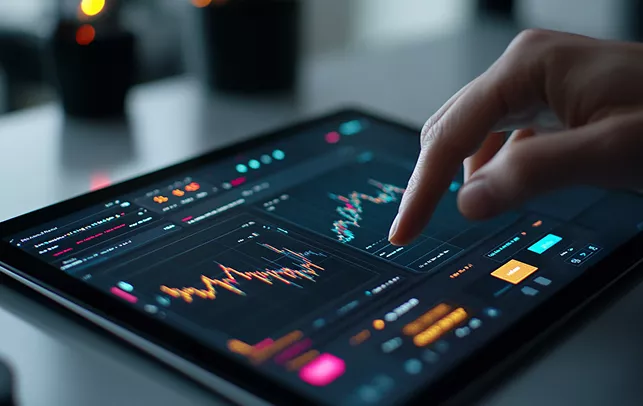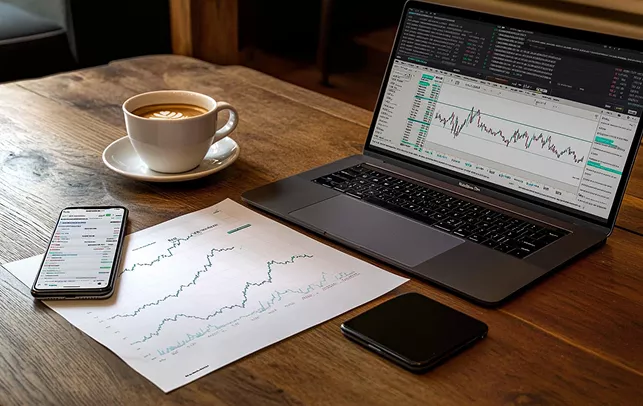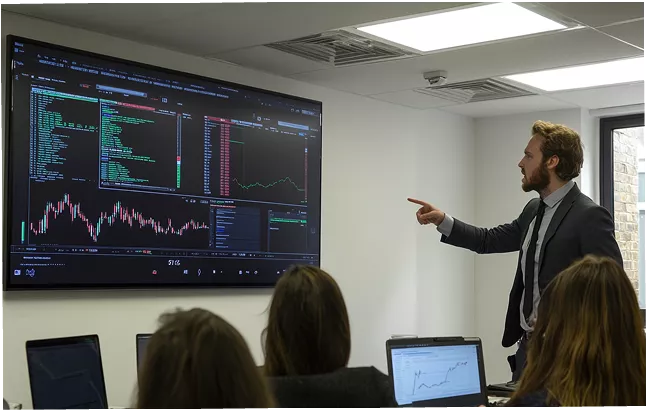Always up-to-date
Our experts continuously werify broker data to provide the most up-to-date information
Lest updated on
Jun 30, 2025
We double-check broker fee details each month which is made possible through parthner paid advertising. Learn more this here.
Best DMA Forex Brokers
Direct Market Access (DMA) brokers are a top pick for forex traders who want clear and fast trades in 2025. This article looks at the best DMA brokers, their features, benefits, and key factors to help you trade well with DMA Forex.


What is a DMA Forex Broker?
A DMA forex broker lets traders connect straight to the interbank market, with no middleman like a dealing desk. Unlike typical brokers, DMA brokers link you to big banks (like Deutsche Bank or UBS) for real-time prices and trade execution. This setup makes trades clear and works well for traders who want true market conditions in forex DMA.
How Does DMA Work in Forex Trading?
DMA brokers collect buy and sell prices from banks and other big players through a system called an aggregator. When you place a trade, it goes straight to the interbank market to match with the best price. For example, if you buy EUR/USD, your order pairs with a bank’s price, making the process open. DMA gives you access to deep pools of money and shows detailed price levels, which helps make trades better in forex direct market access.





DMA vs. ECN vs. STP Brokers: Key Differences
DMA, ECN, and STP brokers all skip the dealing desk, but they handle trades differently:
- DMA: Connects you straight to banks with clear contracts, deep market views, and options to adjust trades.
- ECN: Links traders to a network of users for private trades, often with smaller spreads but less market detail.
- STP: Sends your orders to banks with a small fee added, which might not be as clear as DMA due to quick trade methods.
- DMA offers the most direct path to the market, while ECN focuses on privacy, and STP might involve broker adjustments, which affects clarity in direct market access forex.
Who Should Use a DMA Broker?
DMA brokers work best for skilled traders who use fast strategies like scalping or day trades. These traders need quick trades, real market prices, and clear costs. For example, scalpers who aim for 5-10 pips per trade on EUR/USD prefer DMA for its speed and low spreads. Beginners might find DMA tricky due to fees and higher deposits, but advanced traders benefit from its control and clarity in direct market access brokers.
Best DMA Forex Brokers
Advantages and Disadvantages of DMA Forex Brokers
DMA brokers have clear strengths and some downsides for direct market access broker trades. Here’s a simple breakdown:
| Aspect | Advantages | Disadvantages |
| Trade Clarity | No hidden markups, real market prices. | Fees can add up for small trades. |
| Speed | Fast trade execution, no delays. | Needs a bigger deposit to start. |
| Control | Deep market view with Level II prices. | Hard to trade large volumes at times. |
| Reliability | No re-quotes, true market conditions. | Complex for new traders. |
DMA brokers offer a fair and fast way to trade, but costs and complexity can be a challenge in DMA broker setups.
Benefits of Trade with a DMA Broker
DMA brokers provide key perks for traders. First, they have no re-quotes, so your trade happens at the price you see. Spreads come straight from the market, often as low as 0.1 pips on pairs like EUR/USD with brokers like Pepperstone. Execution speed is high, with trades filled in milliseconds, which suits scalpers. You also get a clear view of market depth, helping you plan trades better in DMA brokers.
Potential Drawbacks of DMA Brokers
DMA brokers have some cons. They often charge fees, like $7 per lot, which can hurt small accounts. Deposits are higher—think $500 or more with brokers like IG—compared to standard accounts. Large trades might face slippage if market liquidity is low, especially during news events. New traders might struggle with the setup and costs, so DMA often suits those with experience in direct market access brokers.
Key Factors to Consider When You Choose a DMA Forex Broker
Pick a DMA broker with care to match your trade needs from the direct market access broker list. Focus on these points to find the best fit.
Trade Conditions: Spreads and Fees
Look at spreads and fees to know your costs. DMA brokers like XTB offer raw spreads from 0.1 pips but charge a fee, like $3.50 per lot. Check for hidden costs, such as overnight swap fees, which can add up. For example, a 0.01-lot trade on EUR/USD with a 0.5-pip spread costs just $0.05, but fees might double that. Compare brokers to find the best deal for DMA Forex brokers.
Execution Speed and Market Liquidity
Fast trades and deep liquidity matter in forex trade DMA accounts. DMA brokers should fill orders in under 10 milliseconds to avoid slippage. Liquidity ensures your trades match at the best price, even for larger lots. For instance, Pepperstone connects to 20+ banks, providing deep liquidity for pairs like USD/JPY. Test execution speed on a demo account during busy market hours to confirm quality.

Regulation and Broker Transparency
Choose a regulated broker for safety in direct market access brokers list. Look for licenses from top bodies like the FCA, ASIC, or CFTC. Regulated brokers, such as OANDA, follow strict rules and keep your funds safe in separate accounts. Transparency is key—DMA brokers should show real market prices with no markups. Check reviews on sites like ForexBrokers.com to confirm a broker’s reputation.
Trade Platforms and API Access
DMA brokers should support platforms like MetaTrader 4 (MT4), MetaTrader 5 (MT5), or cTrader. For example, FOREX.com offers MT5 with DMA access, showing Level II prices. API access lets you automate trades or connect custom tools, which suits algo traders. Test the platform on a demo to see if it meets your needs for DMA Forex.
Deposit and Withdrawal Conditions
Check how fast you can add or take out money. Good DMA brokers like AvaTrade process withdrawals in 1-2 days with no fees for amounts over $100. Others might charge $10 for bank transfers. Look for brokers with easy options like cards or e-wallets (e.g., PayPal, Skrill). A $500 minimum deposit is common for DMA accounts, so plan your budget.
Best Trade Strategies for DMA Brokers
DMA brokers provide fast execution and real market prices, which opens up many ways to trade. Below are more strategies to help you make the most of DMA Forex brokers. Each approach suits different goals, so test them on a demo account first to find what works for you.
Scalp and DMA Brokers
Scalpers aim for small profits, like 5-10 pips per trade on pairs like EUR/USD. DMA brokers help with their low spreads, often 0.1 pips, and quick trades, usually under 10 milliseconds. For example, a 0.01-lot trade with a 5-pip gain makes $0.50. Use busy market hours, like the London-New York overlap (8 AM to 12 PM GMT), to catch fast price moves. Pick brokers like Pepperstone for low fees, but watch out for costs that can cut into your profits. Scalp only when the market has enough action to avoid price gaps.

Day Trade with DMA
Day traders buy and sell within one day, using DMA’s clear prices to spot opportunities. For instance, trade GBP/USD by buying at a support level, like 1.3000, and selling at resistance, like 1.3020, for a 20-pip gain ($20 on a 0.1 lot). DMA’s fast execution helps you act on quick price changes. Check the economic calendar to avoid news events that might cause sudden price jumps. Brokers like IG work well for day trades because of their deep liquidity, which keeps prices steady during active hours.
Swing Trade with Direct Market Access
Swing traders hold trades for days or weeks, which fits direct market access forex. DMA gives raw spreads and deep market views, ideal for pairs like AUD/USD. For example, buy at 0.6700, target 0.6900, and earn 200 pips ($20 on a 0.1 lot). Use DMA’s Level II pricing to confirm trends by checking buy and sell orders. Watch for overnight fees, which can add up over long holds—brokers like XTB often have lower swap costs. Swing trades work best when the market shows a clear direction, so use indicators like moving averages to find trends.
Algorithmic Trade and API Integration
Algo traders can automate trades with DMA’s API access. For example, with IG’s API, you can set a system to buy USD/JPY when the RSI hits 70, with a 30-pip stop-loss. DMA’s fast execution makes algo trades reliable, as orders fill at real market prices. Test your code on a demo account first to catch errors. Use brokers with strong API support, like FOREX.com, to connect custom tools. This strategy suits traders who know coding and want to trade without manual effort, especially in forex trade DMA accounts.
Breakout Trade with DMA
Breakout traders look for price moves after a pair breaks a key level, like support or resistance. DMA brokers help because of their speed and real prices. For example, if EUR/USD breaks above 1.1000 after a consolidation, buy with a 20-pip stop-loss below the breakout point. Target a 40-pip gain at 1.1040 ($4 on a 0.1 lot). Use DMA’s market depth to confirm the breakout—check if buy orders increase after the break. Trade during high-volume sessions to avoid false breakouts. Brokers like OANDA, with tight spreads, work well for this strategy in DMA broker setups.
Range Trade with DMA Brokers
Range traders buy at the bottom of a price range and sell at the top when the market moves sideways. DMA’s clear pricing helps spot true range levels. For instance, if USD/CHF trades between 0.8700 and 0.8750, buy at 0.8700 and sell at 0.8750 for a 50-pip profit ($5 on a 0.1 lot). Use indicators like RSI to confirm overbought or oversold levels within the range. DMA’s fast execution ensures you catch the price at the right moment. Avoid this strategy during news events, as breakouts can trap you. Brokers like AvaTrade, with no re-quotes, suit range trades in direct market access brokers.
Carry Trade with Direct Market Access
Carry traders earn interest by hold positions in pairs with big interest rate gaps, like AUD/JPY. DMA brokers provide raw spreads, which keep costs low for long holds. For example, if Australia’s interest rate is 4% and Japan’s is 0.1%, you earn the difference by buy AUD/JPY. Hold a 0.1-lot position for a week to earn about $3 in interest, minus swap fees. Check the broker’s swap rates, Pepperstone often has competitive ones. Use DMA’s market depth to ensure the pair’s trend supports your trade. This strategy works best in stable markets, so avoid it during high volatility in direct market access forex.
Hedging Trade with DMA Brokers
Hedging traders open opposite positions to lower risk. DMA brokers make this easy with their fast execution and clear prices. For example, if you buy 0.1 lots of EUR/USD at 1.0900 but worry about a drop, sell 0.1 lots of EUR/USD at 1.0890 to lock in a small loss. If the price falls to 1.0870, your loss on the buy is $20, but your sell gains $20, break even. DMA’s transparency helps you set precise entry and exit points. Use brokers like FOREX.com, which allow hedging without restrictions, for DMA forex trades. Watch fees, as two positions double your costs.
Each strategy uses DMA’s strengths, like speed and real prices, to improve your trades. Test them on a demo to see which fits your style best, just like we discussed with Mine Island demo strategies—experiment, analyze, and adjust to keep risks low while you trade with DMA Forex brokers.
Common Mistakes When You Trade with DMA Brokers
Avoid these errors to trade better with a direct market access broker.
Not Understanding DMA Execution Costs
Many traders ignore fees. A $7-per-lot fee on a 0.1-lot trade costs $7, which can cut profits on small trades. Add swap fees for overnight positions, and costs rise. Always calculate total expenses before you trade. For example, a scalper with 50 trades a day might pay $350 in fees monthly, so pick low-cost brokers like XTB.
Overleverage in DMA Trade
High leverage, like 1:500, can lead to big losses. A 100-pip move against a 0.1-lot trade at 1:500 leverage wipes out $500. DMA trades often move fast, so use low leverage, like 1:50, to stay safe. For instance, a 1:50 leverage on the same trade risks $100, which is easier to handle in DMA brokers.

Choose an Unregulated DMA Broker
Unregulated brokers can scam you. Without oversight from bodies like the FCA, your funds aren’t safe. For example, a shady broker might manipulate prices or block withdrawals. Stick to regulated brokers like OANDA or IG, which follow strict rules and protect your money in direct market access brokers list.
Ignore Market Depth and Liquidity
Low liquidity can hurt trades. If you trade 5 lots of EUR/USD during quiet hours, you might face slippage because there aren’t enough buyers or sellers. DMA brokers show market depth, so check it before trades. For instance, trade during busy hours (e.g., 8 AM GMT) to match orders easily in forex DMA.
FAQ: DMA Forex Brokers
What is the Difference Between DMA and ECN Brokers?

Are DMA Brokers Good for Beginners?

Do DMA Brokers Have Fixed or Variable Spreads?

What Are the Minimum Deposit Needs for a DMA Account?

How Do DMA Brokers Make Money?

What is the Best DMA Forex Broker in 2024?




